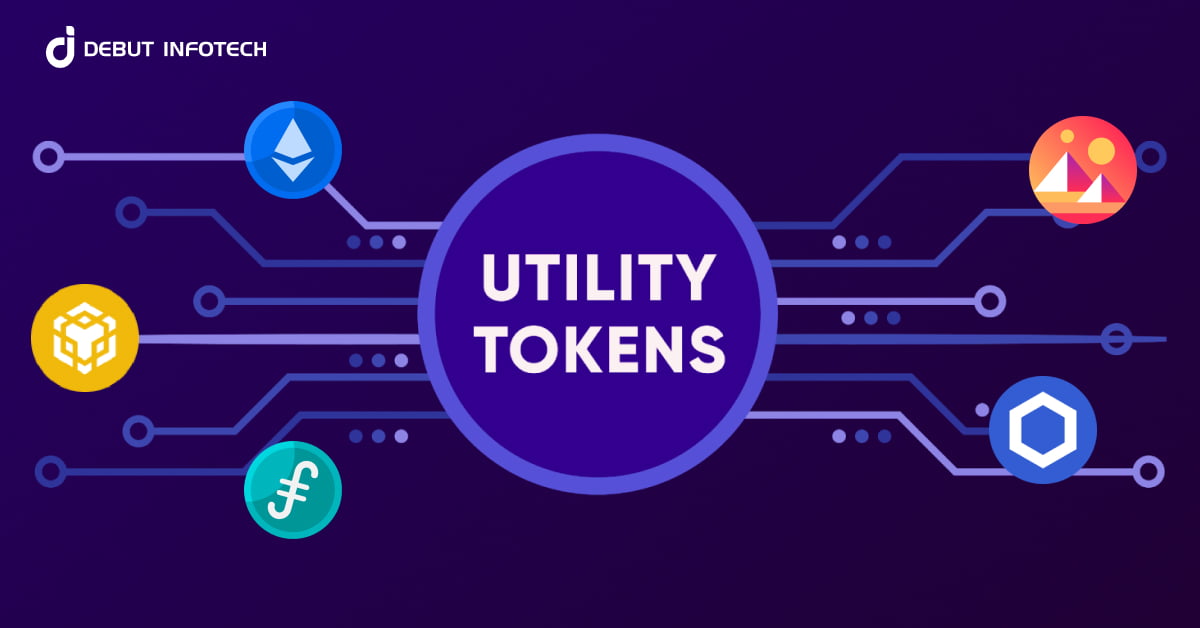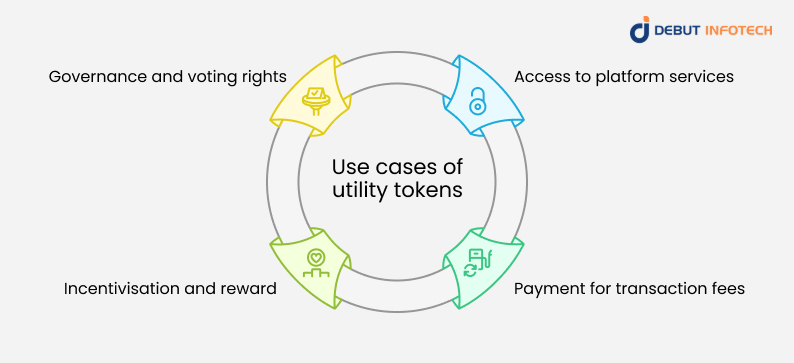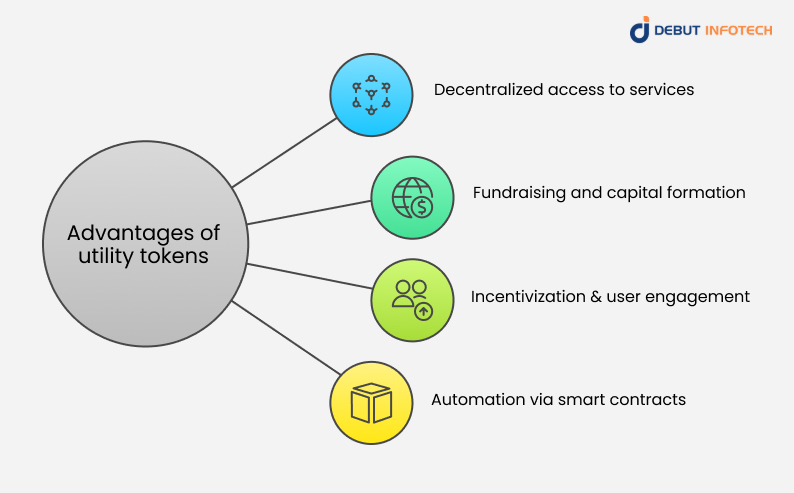Table of Contents
Home / Blog / Tokenization
What Are Utility Tokens and How Do They Work?
July 8, 2025

July 8, 2025
The blockchain ecosystem has recently become flooded with numerous crypto buzzwords, and ‘Utility tokens’ is one of them.
If you’re wondering what a utility token is and how it works, you’re not alone.
The rapid growth of cryptocurrency and its wide range of applications across industries has left many people struggling to understand concepts, with some still confused by basic concepts such as blockchain and decentralization within the industry.
In this article, we provide a straightforward and comprehensive explanation of utility tokens. In doing so, we will demonstrate how it differs from similar concepts, explain its creation, and provide some notable examples.
Let’s dive into it.
What are Utility Tokens?
To understand what a utility token is, we must first understand what it is not.
Utility Tokens aren’t meant to be investment vehicles; this means that holding them does not equate to having a financial stake in the project.
Instead, they are created to grant Blockchain users access to certain features, services, or functions offered by a Blockchain-based platform. Think of utility tokens as digital VIP passes. The value comes from the actual utility it provides, such as paying transaction fees, unlocking premium content, or casting a vote in a decentralized ecosystem.
Essentially, a utility token is a ‘crypto with utility’ or a digital asset with a specific use case.
Utility Tokens are typically issued through fundraising processes, such as initial coin offerings (ICOs), initial exchange offerings (IEOs), or airdrops with the help of ICO Development Services like Debut Infotech Pvt Ltd. They are designed for use within the blockchain network and are not intended for trading purposes to generate a profit.
Because they are programmable via smart contracts, they facilitate automation and transparency, two of the most alluring qualities of decentralized finance (DeFi) and Web3 space.
Additionally, utility tokens are built on Blockchain platforms such as Ethereum, Binance Smart Chain, or Solana. These platforms enable the creation, distribution, and processing of tokens. These mechanisms facilitate a self-sustaining digital economy where users, developers, and platforms can interact without the need for an intermediary.
Utility Tokens vs Security Tokens
Utility tokens and security tokens are similar concepts within the cryptocurrency space – they are both Blockchain-based tokens, and they often get confused. The difference between them lies in their underlying purpose and regulatory framework.
Let’s explore these differences.
The purpose of a utility coin is primarily functional.
So, how do utility tokens work?
Users who own utility tokens can access products or services offered by the issuer platform. For example, a token might be used to get extra storage space on a decentralized file hosting platform or to unlock advanced functions in a dApp. Because their primary function is functional, their value comes from their usefulness and adoption of the underlying platform. They are not designed with investment in mind, and you typically cannot trade them across different platforms.
Examples of top utility crypto coins include:
- The Sandbox (SAND): A utility token within the SAND network that facilitates the buying and selling of virtual land (LAND).
- Binance Coin (BNB): A utility token created by Binance for paying for goods and services within and outside Binance’s smart contract blockchain
- Chainlink (LINK): A utility token that serves as currency to pay Chainlink network operators for retrieving and preparing off-chain data and performing computations
Conversely, a security token is an investment vehicle: those who purchase a security token own a financial stake in the company or project and can trade the tokens to generate a profit.
These tokens are similar to traditional securities, such as bonds or stocks, and are subject to strict regulatory supervision. As such, they must comply with financial regulations such as the U.S. Securities and Exchange Commission’s (SEC) guidelines and other similar regional guidelines.
If you are still confused about how to differentiate between a utility and a security token, the Howdy Test can serve as a benchmark for making that distinction
Below is a table that clearly shows the main differences:
| Features | Utility Token | Security Token |
| Main function | Used to access a service or platform | Represents a financial stake in the project |
| Regulatory status | Little to no regulation | Strictly regulated |
| Ownership rights | None | It may give you access to voting rights or offer a dividend |
| Market purpose | For platform engagement | Profit generation |
| Example | BAT, MANA, BNB | tZero, Securitize, Polymath |
How are utility tokens created?
Creating a utility token is a complex process that involves the seamless integration of various technical and economic components, including blockchain technology, smart contract programming, and token economics.
Most reputable utility tokens often trust a token development company like Debut Infotech Pvt Ltd to handle the entire process.
To begin the process of creating a utility token, developers have to select a blockchain platform. The blockchain platform chosen affects transaction speed, cost, and the level of development support. Popular choices include Ethereum, Binance Smart Chain, Solana, and Avalanche.
After selecting a platform, developers follow specific token standards to ensure that the tokens are interoperable and compatible with existing wallets and platforms.
Next, they draw up a smart contract.
Smart contracts play a central role in the creation of a utility token. A smart contract determines how the token functions, including the number of tokens in existence, who can hold them, and what they can do within the platform.
Once the smart contract is drafted, it undergoes rigorous testing to identify any bugs or vulnerabilities that could be exploited by hackers to compromise the system. After testing, the smart contract is deployed and is minted on the blockchain. Once minted, the tokens are distributed through various methods, including initial coin offerings (ICOs), initial exchange offerings (IEOs), or airdrops.
But that’s not all.
To ensure that a token remains valuable and useful within its ecosystem, developers must also plan the tokenomics of the utility token. This involves stipulating the total supply, inflation rates, vesting schedules, and use cases. When properly designed, a utility token can encourage engagement, loyalty, and vibrant decentralized communities.
Build a trustworthy and valuable token with secure, compliant utility token development.
Contact our token development experts to create secure and scalable tokens today.
Use cases of utility tokens
Because utility tokens are versatile and play a crucial role in facilitating various functionalities across blockchain ecosystems, they find applications across multiple industries, including finance, advertising, gaming, and cloud computing.
If you’re looking to launch a utility token, a crypto token development company may help you adopt the token for the following use cases.

1. Access to platform services
The best utility tokens can act as ‘bouncers’ that reserve access to the platform’s offerings to those who hold them. For example, Filecoin’s FIL token allows users to pay for decentralized file storage, while Golem’s GLM grants access to distributed computing power.
2. Payment for transaction fees
Some blockchains require users to pay for processing transactions or executing smart contracts. These fees are typically paid in the blockchain’s native utility token. One prominent example is Ethereum’s ETH. It is used to pay for gas fees and maintain the network’s operation.
3. Incentivisation and reward
Platforms offer utility coins to incentivize participation. Users can receive these incentives when they stake, provide liquidity, or interact with the app. A good example is Brave Browser’s Basic Attention Token (BAT), which compensates users for viewing ads.
4. Governance and voting rights
In decentralized autonomous organizations (DAOs), utility tokens are often used as governance tokens. Token owners confer voting privileges–token holders can vote on feature upgrades, community grants, and changes to fee structures. This approach democratizes decision-making, ensuring that token holders have a stake in the platform’s evolution.
Examples of Notable utility tokens
In this section, we provide a utility coins crypto list of notable examples with real-world applications.
Basic Attention Token (BAT)
Central to the Brave browser ecosystem, this token was developed to revolutionize the advertisement industry by cutting out the middleman and compensating users for their attention. The platform compensates users for viewing ads, and publishers and content creators also receive BAT when users engage with their content.
Filecoin (FIL)
Filecoin facilitates decentralized data storage. It provides users with access to file storage on the Filecoin network, which is essentially a blockchain-based alternative to Dropbox. Additionally, users can earn FIL by renting out unused disk space.
Chainlink (LINK)
Chainlink is a decentralized Oracle system that connects smart contracts to real-world data. LINK tokens are used to pay providers who deliver off-chain information, such as weather data, sports scores, or asset prices, to on-chain applications.
Golem (GLM)
The Golem network gives users access to extended computing resources. With the GLM token, individuals in fields that require complex computation, such as CGI rendering, artificial intelligence, and scientific research, can rent processing power. This decentralized cloud computing approach reduces reliance on centralized providers like Amazon Web Services or Google Cloud.
Decentraland (MANA)
Decentraland users can use MANA to purchase virtual properties and participate in immersive experiences. Additionally, MANA holders can vote on changes to Decentraland’s virtual world policies and development priorities.
Binance Coin (BNB)
The Binance Coin was initially created as a discount token for trading on the Binance exchange. Since then, it has grown into a utility token with various functions within the Binance Smart Chain (BSC), including payment of transaction fees, staking, participation in token sales, and more.
Advantages of utility tokens
The best utility tokens offer a range of benefits that make them an important component in the cryptocurrency and Blockchain ecosystem. Some of these benefits include:

Decentralized access to services
The most significant advantage of utility tokens is that they provide users with decentralized access to digital services. Unlike traditional systems, where access controls rest solely on a centralized authority, utility tokens enable users to interact directly with platform services, regardless of their nature. This automated approach enables cheaper and more efficient operations while enhancing engagement.
For example, in a decentralized video streaming service, users may be required to hold a platform-specific utility token to access and watch content, upload media, or access premium features. This approach discourages freeloaders and bots, thus maintaining the integrity of the platform.
Fundraising and capital formation
Blockchain developers and startups can raise capital by selling utility tokens through mechanisms such as Initial Coin Offerings (ICOs) and Initial DEX Offerings (IDOs). This operation provides early supporters with access to future services, thus aligning their interests with the project’s success.
This approach presents a unique advantage over traditional venture Capital models–decentralized fundraising removes geographical barriers and grants global accessibility to investment opportunities. Thus, it democratizes capital formation.
Incentivization and user engagement
A well-designed utility token encourages engagement by incentivizing continued interaction within the platform. Many Blockchain platforms reward users for contributing content, staking assets, referring new users, or simply using the platform.
For instance, Web3 social media platforms utilize utility tokens to reward users for publishing high-quality content or engaging with posts. This approach encourages user activity and ensures that value flows back to the community, rather than being captured solely by a centralized entity.
Automation via smart contracts
Utility tokens are programmable. This means that they can be coded into smart contracts that execute specific actions automatically once predefined conditions are met. This advanced automation reduces the need for manual oversight and significantly reduces administrative costs.
For example, a utility token can be programmed to release payment once a service has been delivered or to grant access to a service or product once payment has been made. This level of automation is fundamental for DeFi operations where transactions occur without the need for intermediaries.
Risk and limitations
While utility tokens offer various benefits to their holders, they also come with certain risks and limitations. Exploring these risks and limitations provides a comprehensive understanding of the subject, equipping you with the knowledge necessary to make informed decisions.
Regulatory uncertainty and compliance risks
One of the most pressing concerns surrounding utility tokens is the regulatory ambiguity that surrounds them–different regions have differing interpretations of what constitutes a security. As such, a token may be considered a utility token in one region and a security token in another. This inconsistency often presents legal difficulties for developers.
Market volatility and speculative behavior
The cryptocurrency market is largely influenced by market sentiment or speculation. Therefore, it is often capricious. While this may present profit opportunities, it also introduces risk. This instability can make the token too expensive for users who seek to access features within a blockchain ecosystem. On the other hand, a crash in token value may discourage participation or cause users to abandon the ecosystem altogether.
Dependence on project viability
The value of a utility token depends on the success of the project that issues it. If the platform is unpopular, fails to deliver on its promises, or is poorly secured, the token may become worthless. This dependency creates a high-risk environment, especially for early investors.
Many projects may experience initial hype, raise significant funds, and then fail to execute their roadmap. This strips the token of purpose and eventually of value. There’s also the added risk of little to no consumer protection in decentralized markets, which makes it nearly impossible for users to recover lost funds.
Scam potential and lack of transparency
The absence of regulatory oversight in decentralized markets not only makes fund recovery difficult, but it also exposes investors to scams. This is further compounded by the relative ease of creating and launching a utility token. These factors make it easy for bad actors to exploit the system — a common occurrence during the ICO boom of 2017-2018, when many projects raised funds and then disappeared. This practice is commonly referred to as a “rug pull”.
Today, while such scams still exist, investor education and the enforcement of stricter regulations have reduced occurrences. Additionally, the introduction of safer fundraising models such as Initial Exchange offerings has also significantly curtailed these fraudulent activities.
Launch your utility crypto token to drive business growth
Consult with our experts to develop a comprehensive strategy for utility token development.
Conclusion
A careful analysis of the history and application of utility tokens reveals the importance of trust in the stability and reputation of both the utility token and the blockchain platform that supports it. Everything from fundraising to token distribution, user adoption, and long-term utility is influenced by how transparent, secure, and reliable a project is.
If you’re a business leader or executive who’s looking to create your own native utility coin, Debut Infotech Pvt Ltd’s token development services were created specifically for you. We’ll create tailored solutions based on your business objectives that help you inspire trust and build long-lasting decentralized systems.
Frequently Asked Questions
A. While both are digital currencies, they differ significantly in their purpose and application. Utility tokens are designed to help users access services, pay fees, or participate in governance within a specific platform. In contrast, cryptocurrencies like Bitcoin and Litecoin are used to store value or as a medium of exchange.
A. Yes, you can. Utility tokens share certain similarities with stocks. They can be purchased and traded, and their prices may increase. However, they differ from stock in that they do not represent ownership in a company or platform. Additionally, unlike stocks, they are designed primarily for use and not as an investment vehicle.
A. You can purchase utility tokens on centralized exchanges (CEXs), such as Binance, Coinbase, and Kraken, or on decentralized exchanges (DEXs), including Uniswap, Pancakeswap, and Sushiswap. Remember to verify that the token is listed on a trusted exchange before making a purchase. Additionally, you should be cautious of phishing sites or counterfeit tokens.
A. When evaluating a new utility token, you should look out for vague or unrealistic whitepapers, anonymous or unverified development teams, a lack of product or working prototype, promises of guaranteed profits, and no clear use cases.
A. Although they are considered high-risk investments, utility tokens can offer access to blockchain services and potentially generate substantial profits. Platform adoption, consumer demand, and regulatory clarity all affect their worth. In addition to conducting extensive research, investors should be aware of the potential for project failure and volatility.
Talk With Our Expert
USA
2102 Linden LN, Palatine, IL 60067
+1-708-515-4004
info@debutinfotech.com
UK
Debut Infotech Pvt Ltd
7 Pound Close, Yarnton, Oxfordshire, OX51QG
+44-770-304-0079
info@debutinfotech.com
Canada
Debut Infotech Pvt Ltd
326 Parkvale Drive, Kitchener, ON N2R1Y7
+1-708-515-4004
info@debutinfotech.com
INDIA
Debut Infotech Pvt Ltd
Sector 101-A, Plot No: I-42, IT City Rd, JLPL Industrial Area, Mohali, PB 140306
9888402396
info@debutinfotech.com





Leave a Comment